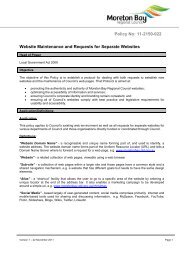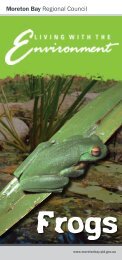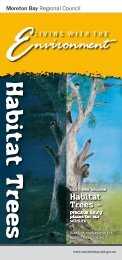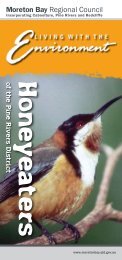Groundsel bush Baccharis halimifolia - Moreton Bay Regional Council
Groundsel bush Baccharis halimifolia - Moreton Bay Regional Council
Groundsel bush Baccharis halimifolia - Moreton Bay Regional Council
Create successful ePaper yourself
Turn your PDF publications into a flip-book with our unique Google optimized e-Paper software.
Description and general information<strong>Groundsel</strong> <strong>bush</strong> is a densely branched shrub usually nomore than 3 m high. Stems are green, maturing to brownand woody. Bark of mature plants is deeply fissured.Leaves are dull green, alternate, wedge shaped, 2.5–5 cmlong and 1–2.5 cm wide, with a few lobes in the upper part.It has a deep branching taproot with numerous fibrouslaterals in the upper soil.Male and female flowers are borne on separate plants.Male flowers are pale yellow and open around mid tolate March, slightly earlier than the female flowers.Female flowers are white and inconspicuous at the end ofbranches until seeds are fully developed. Then the planthas a fluffy appearance, with tufts of white hair (aroundlate March to early April) that begin to blow the fluffyseeds in the breeze from mid to late April.Seeds germinate readily with rainfall; however, if theybecome buried they can remain dormant for several years.Seeds are readily transported by wind, running water,vehicles and machinery. Soil disturbance in infestedareas usually leads to substantial germination. Furtherinfestation occurs unless the ground is sown to pasture orother competitive ground cover.PreventionThe spread of groundsel <strong>bush</strong> threatens the sustainabilityof agriculture and other land uses. <strong>Groundsel</strong> <strong>bush</strong> canreplace plants and destroy habitat for native wildlife.The best form of weed control is prevention. Always treatweed infestations when small—do not allow weeds toestablish. Weed control is not cheap, but it is cheaper todo it now rather than next year, or the year after. Propermanagement planning ensures you get value for eachdollar spent.ControlLook at your weed problem carefully. Can you realisticallyeradicate it? Or should you contain the weed to stop newinfestations developing while you reduce existing ones?What are you required to do by legislation? How does weedcontrol fit into your property management plan? What canyou do to restore areas and prevent re-establishment?The best approach is usually to combine differentmethods. Control may include chemical, mechanical, fireand biological methods combined with land managementchanges. The control methods you choose should suit yourparticular situation.Habitat and distribution<strong>Groundsel</strong> <strong>bush</strong> is a native of Florida (United States) andcoastal areas adjacent to the eastern side of the Gulf ofMexico.It was introduced into the Brisbane region as anornamental plant in 1900 and has spread along the coastalareas of south-east Queensland (north to Miriam ValeShire) and down the New South Wales coast. Scatteredplants have occurred as far west as the Chinchilla region.<strong>Groundsel</strong> <strong>bush</strong> is a rapid coloniser of cleared, unusedland and is particularly suited to moist gullies, salt marshareas and wetlands. It also does well on high, clearedslopes.Most germination occurs in the autumn/winter period.Plants normally do not flower in the first year of growth.Plants that are 2m tall can produce from 500 000 to amillion seeds.Seeds from mature plants drift in the breeze like thistleseeds, most falling within a few metres of the parent <strong>bush</strong>.Wind updrafts can carry seeds many kilometres.Management strategiesIn grazing situations, good pasture management willgreatly reduce groundsel <strong>bush</strong> invasions. Slashing, timelyuse of fertiliser and management of stocking rates canassist in control by maintaining a healthy pasture. Goodpastures provide competition to limit re-invasion ofgroundsel <strong>bush</strong>es. Consult Department of Employment,Economic Development and Innovation (DEEDI) pastureagronomists on the best options for your property.For tall, dense infestations, burning can reduce theamount of above-ground material (and even kill the oddplant) making it a lot easier to spray regrowth. Annualburning does not reduce existing plant numbers, butallows grasses to establish more quickly and out-competegroundsel <strong>bush</strong> seedlings.Regular slashing over a period of several years willresult in a decreased level of infestation. In non-grazingsituations, reforestation will eventually assist in controlof groundsel <strong>bush</strong>. However, it is important to ensure thatseed production is prevented while trees are establishing.2 <strong>Groundsel</strong> <strong>bush</strong> <strong>Baccharis</strong> <strong>halimifolia</strong>



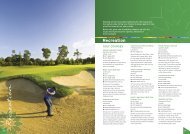

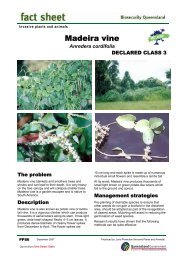
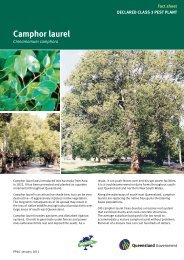


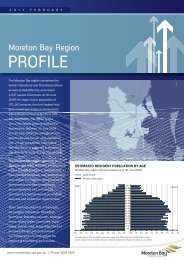
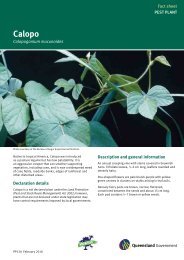

![Kumbartcho Brochure [PDF 540KB] - Moreton Bay Regional Council](https://img.yumpu.com/47220970/1/190x101/kumbartcho-brochure-pdf-540kb-moreton-bay-regional-council.jpg?quality=85)
